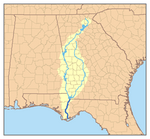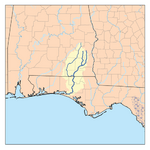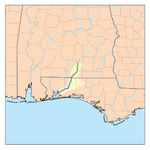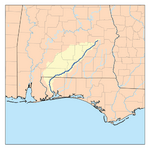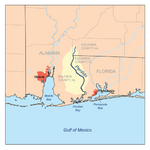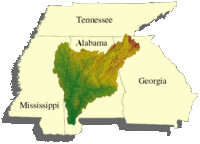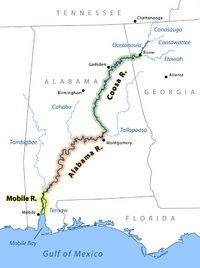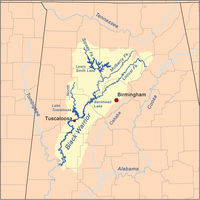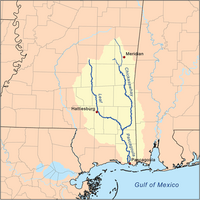List of rivers of Alabama facts for kids
Alabama is a special state in the United States, especially when it comes to its rivers! It has over 132,000 miles of rivers and streams, which is a huge amount of freshwater. What makes Alabama's rivers truly amazing is their incredible variety of life. They have more different kinds of freshwater animals than any other state in the US, and they are even among the most diverse waterways in the entire world! For example, 38% of all the fish species in North America, 43% of its freshwater snails, 51% of its freshwater turtles, and 60% of its freshwater mussels live right here in Alabama's rivers.
Contents
How Rivers Flow: Drainage Basins
All the rivers in Alabama eventually flow into the Gulf of Mexico. To understand how they flow, we can group them into something called a drainage basin. Imagine a giant funnel: a drainage basin is an area of land where all the rain and water eventually drains into one main river or a series of rivers that lead to the same large body of water. We'll look at these basins starting from the eastern side of Alabama and moving west. Smaller rivers that flow into a bigger river are called tributaries.
Rivers Flowing to the Eastern Gulf Coast
These rivers start in Alabama and flow south or southeast directly into the Gulf of Mexico, often through Florida.
- Apalachicola River (FL)
- Chattahoochee River
- Cedar Creek
- Cowikee Creek
- North Fork Cowikee Creek
- South Fork Cowikee Creek
- Uchee Creek
- Chattahoochee River
- Choctawhatchee River
- Pea River
- Flat Creek
- Claybank Creek
- Little Choctawhatchee River
- West Fork Choctawhatchee River
- East Fork Choctawhatchee River
- Pea River
- Yellow River
- Five Runs Creek
- Escambia River (FL)
- Conecuh River
- Murder Creek
- Sepulga River
- Patsaliga Creek
- Conecuh River
- Perdido River
- Blackwater River (Perdido Bay)
- Styx River
- Soldier Creek
Rivers Flowing to Mobile Bay
The Mobile Bay drainage basin is the largest river system in Alabama. It collects water from many rivers that join together before flowing into Mobile Bay, which then connects to the Gulf of Mexico.
- Bon Secour River
- Fish River
- Mobile River-Tensaw River
- Spanish River
- Chickasaw Creek
- Alabama River
- Cahaba River
- Oakmulgee Creek
- Shades Creek
- Buck Creek
- Tallapoosa River
- Line Creek (Alabama)
- Uphapee Creek
- Hillabee Creek
- Little Tallapoosa River
- Coosa River
- Hatchet Creek
- Yellow Leaf Creek
- Choccolocco Creek
- Little River
- Chattooga River
- Cahaba River
- Tombigbee River
- Sucarnoochee River
- Black Warrior River
- Big Sandy Creek
- North River
- Locust Fork
*Village Creek *Little Warrior River
*Lost Creek (Mulberry Fork) *Sipsey Fork
- Dog River
- Rabbit Creek
- Halls Mill Creek
Rivers Flowing to the Western Gulf Coast
These rivers are closer to the western border of Alabama and flow into bays that are west of Mobile Bay.
- Bayou la Batre
- Little River
- Pascagoula River (MS)
Rivers Flowing to the Mississippi River
Some rivers in Alabama are part of the huge Mississippi River system. This means their water travels a very long way, through other states, before reaching the Gulf of Mexico.
- Mississippi River (LA, MS, TN, KY)
- Ohio River (KY)
- Tennessee River
- Bear Creek
- Little Bear Creek
- Cypress Creek
- Shoal Creek
- Elk River
- Flint River
- Paint Rock River
- Crow Creek
- Tennessee River
- Ohio River (KY)
See also


